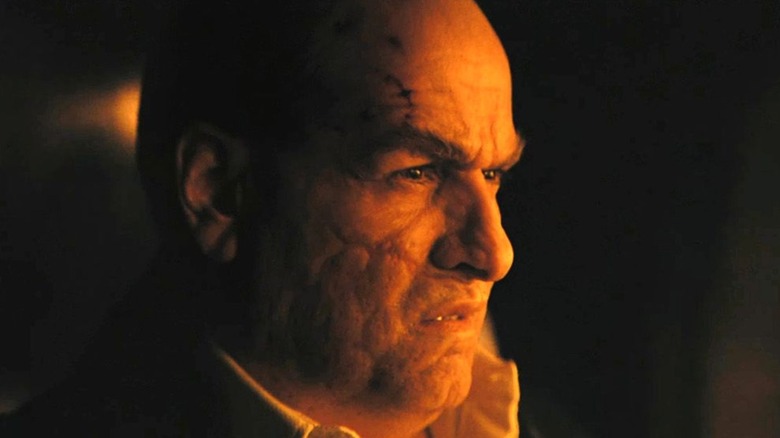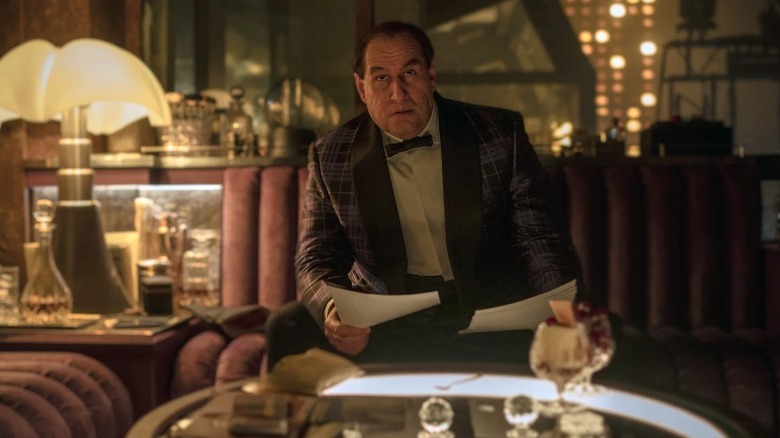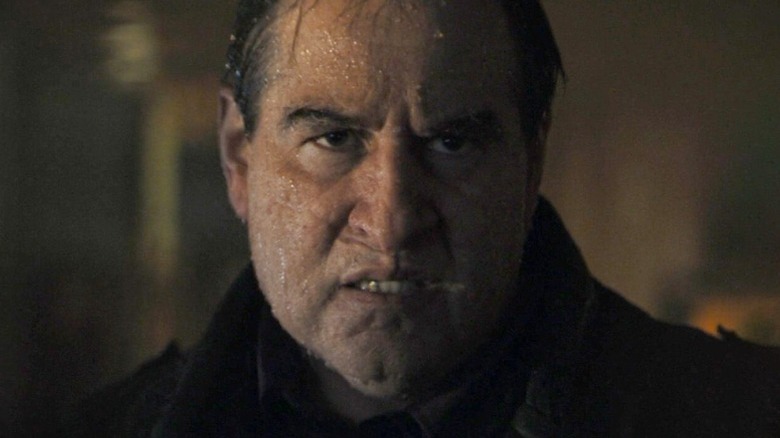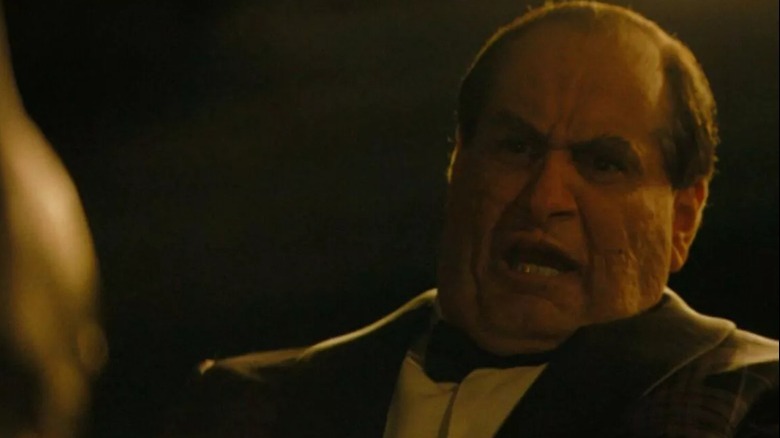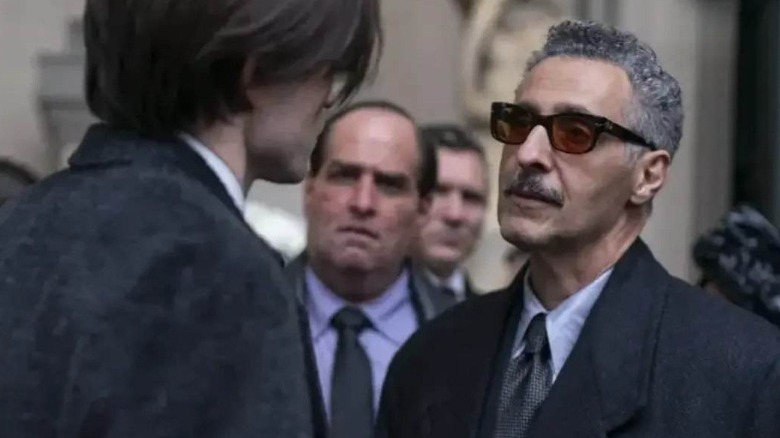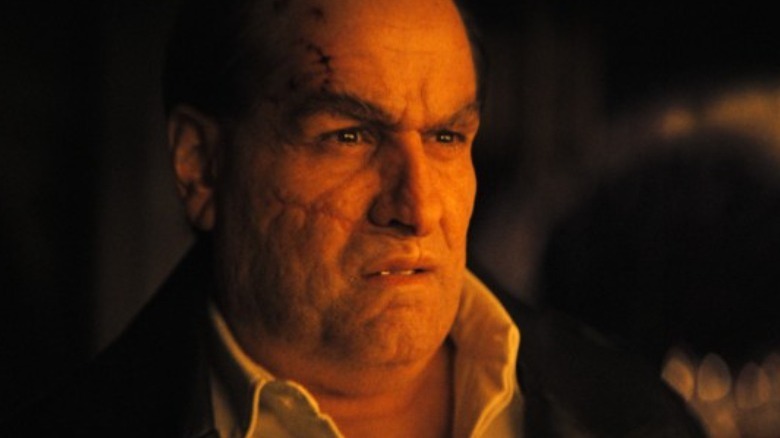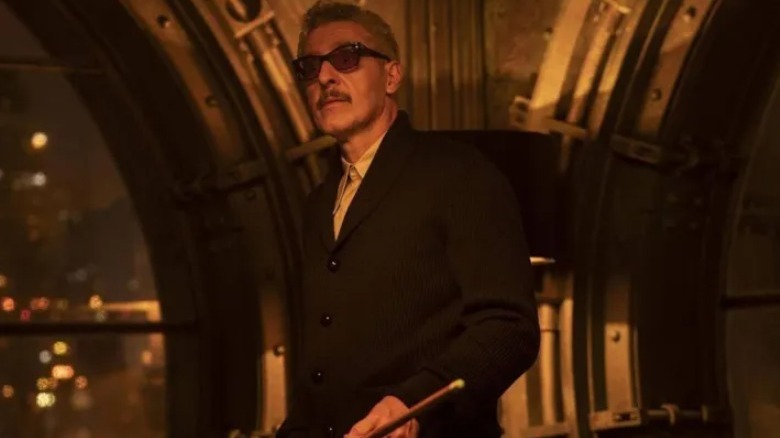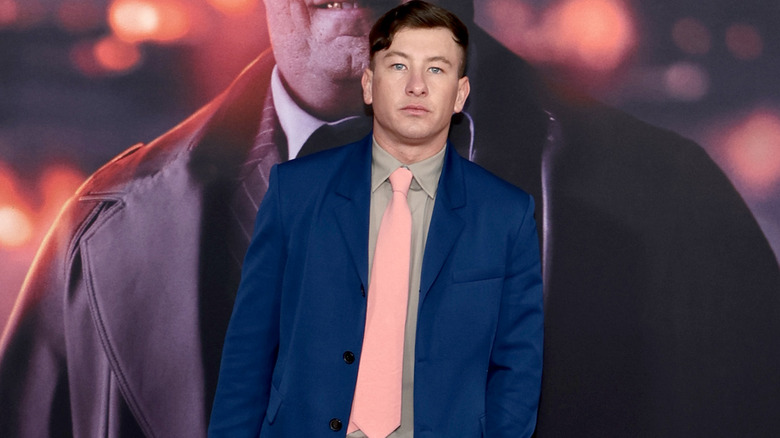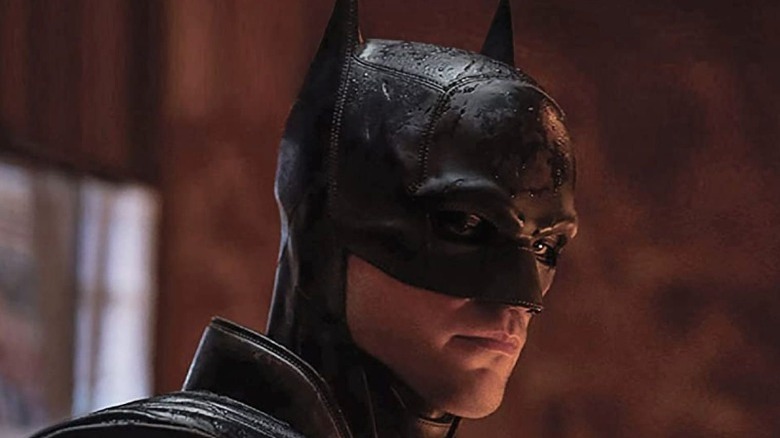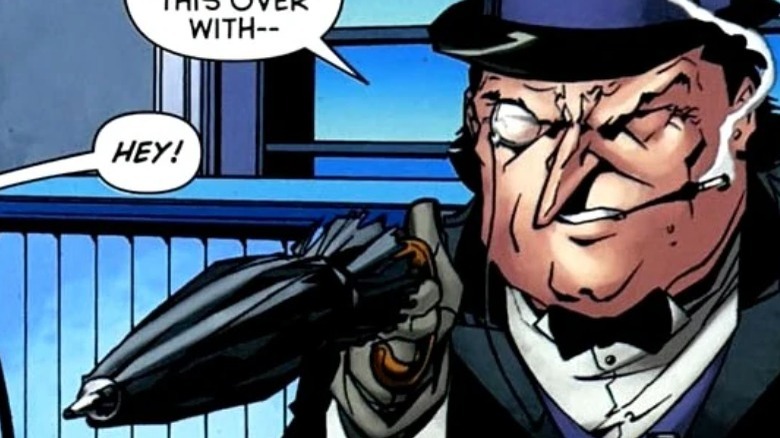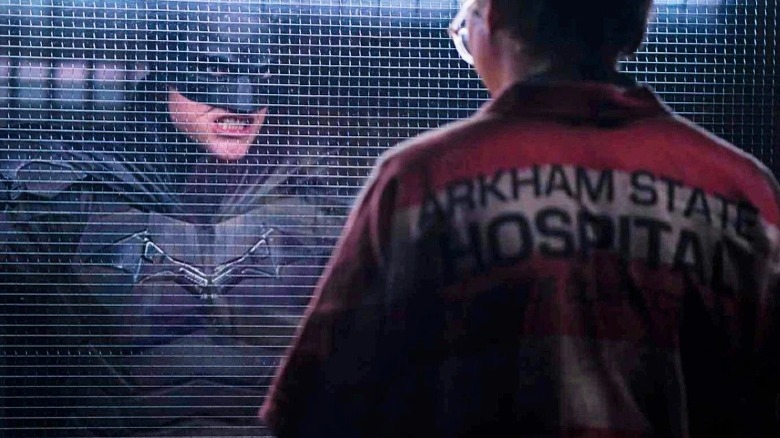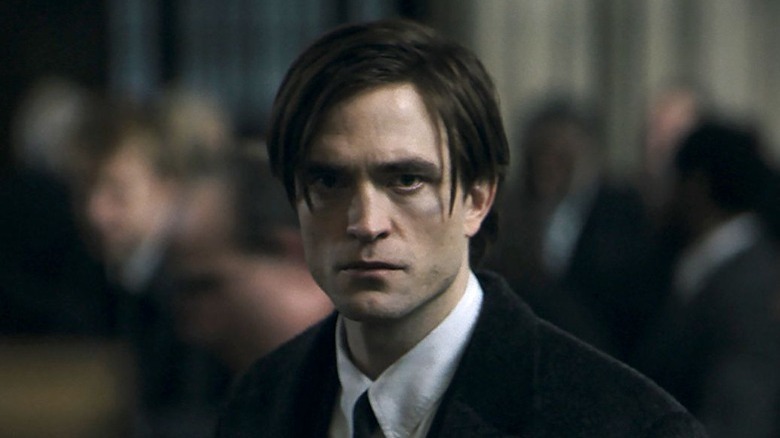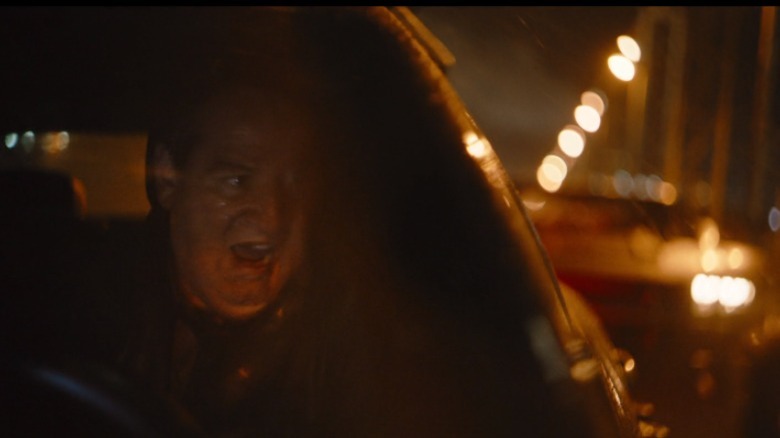Things We Want To See In The Batman's Penguin Spin-Off Series
Warning: this article contains spoilers for "The Batman."
Like a mean-looking Batmobile streaking out of the flames, "The Batman" brings the Caped Crusader roaring back to the life once again on the big screen. The film has made an unmistakable splash at the box office, and it'd be an understatement to say that fans crave more. While we'll have to bide our time until a proper sequel to hit theaters, we don't have to wait long to step back into that fascinating but dark and dreary world. Director Matt Reeves and crew built a colorful Gotham City rich with a history begging to be explored. The HBO Max series starring Colin Farrell's incarnation of the Penguin will grant us passage into that world once again.
"The Batman" established that the Penguin is a prominent gangster in Gotham, whose power is only outmatched by Carmine Falcone. With the death of Carmine Falcone at the hands of the Riddler, the film leaves us watching the Penguin contemplate a power grab. The exact timeline of the series hasn't been revealed yet. However, there's a chance we could see the events of this series unfold both before (via flashbacks) and after "The Batman." As far as Batman fans are concerned, there's likely a healthy wish list of DC comics lore and references fans are dying to see in the series. Let's take a look at our hopes and dreams for the upcoming show starring Gotham's favorite avian-inspired crook.
The establishment of the Iceberg Lounge
Perhapsone of Gotham's most iconic locales, the Iceberg Lounge offers the criminals of Gotham City a space to relax, enjoy a drink, and rub elbows with their crooked cohorts. While the lounge isn't expressly a villains-only club, the atmosphere and clientele that the business caters to is unmistakable. That's in large part thanks to its owner and operator, Oswald Cobblepot. "The Batman" depicts the Iceberg Lounge as a club in the heart of Gotham and positioned in one of the grungiest-looking city blocks. Even so, the most influential and notable politicians who have been bought and paid for by the mob populate the dimly-lit atmosphere of the club.
In DC comics lore, the Iceberg Lounge is typically utilized as a front for the Penguin's nefarious criminal activities. Showing how the Penguin came to own and operate such an establishment in the world of "The Batman" would help to further establish the Penguin's character. While it's not a story worth dedicating an entire series to, a flashback in the narrative to mark the occasion would be enough to do the origin tale of the business justice.
The Penguin's rise to power
Oz wasn't always a gangster. Obviously, criminals aren't born, they're made. "The Batman" shows Oz already as the sleazy weasel fans have come to expect of him. However, there's something to be said about his journey toward crime. In the film, he already commanded multiple armed thugs and really only reported to Carmine Falcone. The show could show us how he established the position he already enjoys in "The Batman."
Of course, there's something else we all want to know: Will the Penguin seize power following Carmine Falcone's death and the destruction brought upon Gotham City by the Riddler? At the end of the film, we see the Penguin gazing out at the city amid obvious contemplation over his future as a feared gangster. The time to take control is now. Will he do it in the HBO Max series? Only time will tell.
The Penguin's tragic history
In DC comics lore, Oswald endures a depressing backstory. In most iterations of the character, he is often violently bullied and mocked for his stature. Sometimes he was even given the name "Penguin" by his abusers. When he finally became angry enough to furiously retaliate, he'd own the name "Penguin" — reclaiming it as a fearsome symbol. Other versions of his history tell a tale of the unrelenting and harsh realities of leading an impoverished life. His family lost everything and his father died of a pneumonia-like illness brought on by inclement weather. His mother would then force Oswald to carry an umbrella with him everywhere he went, a narrative thread that gave his iconic umbrella a tragic origin. Oswald would then take up criminal activities to rise out of the squalor he lived in for so long.
There are plenty of opportunities and differing versions of the Penguin's origin to choose from. Often, criminals don't become feared gangsters because they enjoyed cushy lives with great friends and caring parents when they came of age. Something steered the Penguin in this direction, and it's a moment worth learning — even if it earns the criminal a modicum of sympathy from viewers.
The Penguin's relationship with Carmine Falcone
The Penguin's most interesting relationship is the one that he enjoyed with Carmine Falcone. The Penguin demonstrated his loyalty to Carmine when he bitterly rejected that idea that he would ever become a rat, even if it were toward a rival, as he understood that Carmine Falcone would have his head. Well, funny enough, his superior was the rat.
Still, the two obviously had an unspoken partnership that stretched back far beyond the events of the "The Batman." And while, Carmine Falcone held the most power within the criminal underbelly, the Penguin wasn't far behind. What led to the Penguin's alliance with Carmine Falcone and why was he so loyal to the mafioso, at least until his own sins were unearthed? While Carmine might be dead in the present, dialogue or flashbacks might serve to flesh out the relationship between the pair that led to them sharing a roof at the Iceberg Lounge.
How he obtained those scars
The Penguin is a visually striking foe. From an artistic stand-point, the effects are so well-done that the Penguin believably looks like an entirely different man than the clean-cut Irish actor we know underneath. All it takes is just one look at Oz's face to understand that he's seen far better days. His exterior is as rough as his aggressive mannerisms. There is noticeable scarring all along his face, indicating that the Penguin has earned his stripes as a feared gangster.
But what exactly happened? How did the Penguin get those scars? Could they be tied to his origin as a feared mobster? Perhaps Oz learned a few hard lessons growing up in the dirty underworld of Gotham City.
There's certainly an argument that, like the Joker from Christopher Nolan's "The Dark Knight," keeping the scars' origins unknown adds to the Penguin's mystique as a character hardened by the streets. However, the Penguin is a very different type of character than the Joker, whose prominence would only be bolstered by revealing the story behind the scar tissue. Hopefully, we learn the truth behind that rugged mug.
The rivalry between Sal Maroni and Carmine Falcone
"The Batman" begins shortly after the city's major bust of Sal Maroni's drug operations. The headline news can be seen framed on the wall of the mayor's abode, as the Riddler quietly stalks him in the early moments of the film. Quickly, we learn that the drug bust was a big façade. When Batman follows the Penguin in an effort to identify him as the potential rat on the Maroni operation, he sees that drops production is alive and well. In other words, the drug bust was all a big show by Gotham's most corrupt politicians, and Sal Maroni was the fall guy for the display. Alternately, perhaps Carmine Falcone, the Penguin, and the rest of the mobsters stepped into fill the void of Maroni's absent leadership in the biz.
The answer is, of course, that both of these statements are true. However, Falcone didn't just "step in" to cover Maroni's departure — he took over the business by design. In fact, it's revealed that Falcone was the one who ratted on Maroni's operations leading to the bust. Perhaps Sal Maroni will have a few things to say about his relationship with Carmine from behind bars. The two crime families are notably major players in Gotham City's criminal underworld. They've often waged war against one another throughout the city's turbulent comic book history, and it could be fertile ground to cover in the "Penguin" spin-off.
How the Joker ended up in Arkham
In the third act of "The Batman," the Riddler partially succeed in his goals. He sought to bring devastation upon Gotham City while assassinating the city's remaining mayoral candidate. Batman and Jim Gordon foiled the assassination attempt, but the city was covered in destructive flooding after the Riddler blew open the walls of the reservoir. Seeing the news cycle from his cell in Arkham, where Batman is hailed as a hero for his part in helping rescue citizens from the devastation, the Riddler becomes visibly upset over his partially foiled plot. One shady character, however, offers the Riddler a bit of comfort.
At this stage, we all know that the neighboring cell mate is none other than the Joker played by Barry Keoghan ("Eternals"). Director Matt Reeves has confirmed as much while speaking to IGN on the subject. Since the Joker is already in Arkham, fans want to know: How exactly did he get there? Has he already gone full-blown Joker once? Matt Reeves stated that the character is definitely in the proto-Joker stage and isn't quite "the Joker" yet. But something must have occurred to land him in Arkham. Perhaps the Penguin series might offer a small detail or reference to the character's tangle with authorities in an effort to tease his emergence in Gotham once more.
The Batman's crusade from the perspective of criminals
"The Batman" provided fans with a brief glimpse at the criminal perception of Batman in the opening moments of the film. As the Bat signal lights up the night sky, criminals are seen quaking in their boots at the sight of darkened alleys and corners of Gotham. They're afraid that they've just been caught, and the Batman will emerge at any point to bring the pain. The swelling musical score aptly portrays the dread criminals begin to feel when they think Batman might be hot on their heels.
With the series focused on the Penguin, it's likely we won't see much of Batman. If we do, it may be shadowy glimpses of the character or quick and flashy action sequences that don't reveal much visually. Regardless, it would be a welcome change in perspective to see the Penguin and his goons discuss the threat of the Batman, fearing some horrific monster lurking in the shadows to hurt them.
The Penguin's iconic umbrella
In comic book lore, as well as past portrayals of the character, the Penguin always has his trusty trick umbrella at the ready. In most cases, the umbrella doubles as a firearm, so he can surprise his targets or simply have a handy assault weapon should the occasion arise. Also, his umbrella is usually made of bullet-proof material, making it a great defensive mechanism.
The Penguin was only seen with an umbrella at the mayor's funeral in the Batman. It may have been just an ordinary umbrella, but a hidden threat could've also been concealed under its handle. While the Penguin's umbrella can often perform a multitude of functions, the reality that Matt Reeves has based his Batman world in possibly limits the uses of the trick umbrella to simply being a hidden firearm at best. Even so, fans will surely want to see the umbrella in action at least once during the series.
References to other prominent Batman characters
"The Batman" did a great job of providing fans with evidence that a greater Gotham lies just outside the bounds of the Riddler narrative. Batman interacts with a litany of characters as both allies and adversaries throughout his career. The film name-dropped the Arkhams, a prominent family who obviously established the famous Asylum. In fact, Martha Wayne is revealed to have been part of the Arkham family. Furthermore, we saw a reference to Edward Elliot. In comic book lore, he was also a wealthy aristocrat who helped modernize the city. In "The Batman," he was a reporter who was slain by Carmine Falcone as a "favor" for Thomas Wayne. This offers evidence of a potential Hush storyline for future sequels where Tommy attempts to exact revenge upon Bruce Wayne, a different but similar vindictive motive as seen in the "Hush" graphic novel.
The Penguin series has an even better opportunity to highlight famous DC comics characters in Batman's world throughout the life of the show. With D.A. Gil Colson violently removed from the picture, perhaps we could see Harvey Dent enter the race for District Attorney. Maybe Jim Gordon's family will be revealed, and we'll see that he has a daughter named Barbara. It's anybody's guess at this point. But highlighting or teasing characters from Batman history will serve Bat fans everywhere.
References to other notable Gotham locales
Matt Reeves' film also engages with the Bat-fan community by namedropping a handful of iconic locales, including Blüdhaven, while visually depicting buildings like Arkham and the Iceberg Lounge. Gotham City is ultimately its own character in the world of Batman. It's rich with plenty of colorful destinations that call back to the Caped Crusader's comics source material. With the Joker making an entrance into this version of Gotham, perhaps we'll see Ace Chemicals, the famous chemical plant where Joker became ... well, the Joker. If Matt Reeves and company decide to bring the Boy Wonder into the mix, Haly's Circus would be a fine reference in the Penguin series.
Oz is also sure to recruit some of the most hardened criminals who either have a record or have no qualms about getting one. As such, convicts from Blackgate Penitentiary might be one of the most worthwhile prison systems to obtain talent from. The toughest and most vile of Gotham's criminals have inhabited Blackgate and they often hear all of the juiciest criminal gossip. There's plenty of opportunities to broaden the scope of the city that has already been established in "The Batman."
More history surrounding the Waynes and Arkhams
In "The Batman" we learned a little bit about Gotham's most prominent families, the Waynes and the Arkhams. Both families helped establish Gotham City, and that Arkham State Hospital is obviously named after the family. Even more interestingly, however, is that Martha Wayne actually belonged to the Arkham family before marrying Thomas Wayne.
While Thomas Wayne targeted a reporter for potentially unleashing damaging material on Martha's mental condition to the public, it's unknown if there was more Thomas hoped to protect. Of course, we do learn that Thomas never had any intention of Carmine Falcone killing the man, and felt intense guilt over the act when he found out that Falcone carried out the murder. He resolved to go report everything to the authorities but was killed before he could do so.
There's still much we could potentially learn about Gotham's two founding families. Perhaps, the Penguin series will dig into that history a bit more.
The Penguin's ambitions for the future
There isn't a shadow of a doubt that Penguin will seize power within Gotham's criminal inner circle. Knowing what we know about Oswald Cobblepot, and his penchant for greed and violence, there won't be many challengers capable of matching his ferocity. Once he claims the late Carmine Falcone's throne, what will he do next? How does he plan to expand his empire in a Gotham now emboldened by the heroism of Batman? The Penguin is going to have to establish his power through fear since his allies at City Hall are likely no more.
All of this, of course, means that the Batman will take notice of the Penguin. Does Oz intend to lead a campaign to bring down the Batman? The Dark Knight will now be the biggest threat to his business and he certainly won't be going away willingly. The Penguin is going to have to deal with the Batman in this theoretical future, and it'll be interesting to see if the HBO Max series starts us down the path to that clash.
